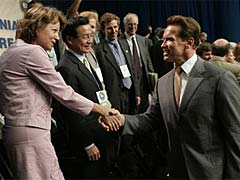| |
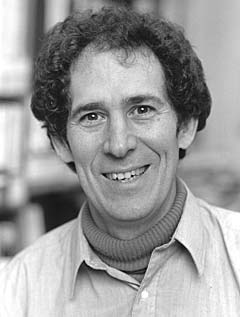
Stephen Schneider, climatologist and professor of biological sciences at Stanford University (Photo: Stanford University)

SCHNEIDER: We would have to figure that out. First of all we could certainly trade with other states and there are other states particularly in the Northeast which, if California does this, are going to do it too. California has always been in that kind of a leadership role and other states want to get in on the act. And we’re therefore going to take action. But if we can get beyond the US and be able to do trades in other countries, I don’t see any absolute legal impediment to it, but it could be some interesting court tests.
We should do it at the federal level, but when the feds won’t do it, the states have to take up the slack. I’ll give you an example. Back in the ‘70s in the energy crisis, California passed a rule fought and screamed at by the electric appliance industry requiring more than a factor of two, improvement in the efficiency of refrigerators. They said it would be too expensive and everybody’s refrigerator would be too small. None of that happened. In fact the feds adopted those rules a few years later and the amount of the electricity saved is so amazing that despite the Vice President telling us that energy efficiency is a moral virtue and doesn’t do anything really and you need supply like ANWR, we have already saved just from refrigerators alone from the initial California rules that went national, two ANWRs in energy, so there’s a lot we can do.
CURWOOD: Professor Stephen Schneider is a climatologist at Stanford University and an advisor to Governor Arnold Schwarzenegger on climate change. Thank you sir.
SCHNEIDER: Thank you Steve.
Back to top
CURWOOD: So far, the federal government has rejected mandatory limits on the emissions of greenhouse gases. But two prominent Senators are trying to change that. Republican John McCain of Arizona and Democrat Joe Lieberman of Connecticut want their colleagues to take another look at a modest cap on carbon emissions. Their Climate Stewardship Act gained a respectable 43 votes the last time the Senate considered it. This time around Senators McCain and Lieberman hope to pick up votes by adding subsidies for climate friendly energy technology—including nuclear power. Living on Earth’s Jeff Young reports that addition has sharply divided advocates for limits on global warming gases.
YOUNG: Two years ago the Climate Stewardship Act drew enthusiastic support from environmentalists. The bill called for the nation’s first cap on greenhouse gases from power plants and an emissions trading system to let the market soften the economic blow.
This year the bill is back—the support is not. That’s because its new version would put hundreds of millions of dollars toward the design and development of three new nuclear power reactors along with other technologies like solar and low-emission coal plants. The act’s primary sponsor, Senator John McCain, never made a secret of his support for nuclear energy. Here’s what he told Living on Earth in September.
MCCAIN: I feel very strongly about nuclear power and you can’t be serious--you can’t be serious--about reducing the effect of greenhouse gas emissions unless you factor nuclear power into the equation.
YOUNG: It’s been three decades since a nuclear reactor went on line in the U.S., due to concerns about cost, safety and radioactive waste--and opposition from environmental groups. McCain hopes to encourage a new generation of safer, more affordable nuclear reactors. He says it’s the only power source that could meet growing energy demand without pumping more carbon dioxide into the atmosphere, making dangerous changes in climate more likely. Greenpeace energy specialist John Coequyt shares McCain’s sense of urgency about climate change but not his views on nuclear power.
COEQUYT: It’s a difficult choice in that we really believe the time to act is now but that being said we can’t support a bill that offers major subsidies to the nuclear power industry. Greenpeace is founded on the notion that nuclear power is not the answer so for us to backtrack from that is just not tenable at this point.
YOUNG: Opposition to nuclear energy is in the DNA of groups like Greenpeace, which grew up in the wake of the nuclear accident at Three Mile Island in the late ‘70s. Greenpeace, the Natural Resources Defense Council, Sierra Club—most of the major environmental groups active in Washington—are now backing away from McCain’s bill. They urge a global warming strategy based on conservation and renewable energy.
Anna Aurilio with the US Public Interest Research Group says her group commissioned a study showing how alternatives like wind, solar and biomass could achieve the CO2 cuts McCain wants without the risks associated with nuclear power.
AURILIO: I don’t really understand, um, how you can be a real environmentalist and think that somehow you need to accept this very, very dangerous energy source to deal with a problem that’s caused by another dangerous energy source. That’s an unacceptable and unnecessary tradeoff and we don’t need to be making it.
YOUNG: James Lovelock considers himself a real environmentalist. The British scientist drew early attention to ozone-depleting chemicals and climate change and developed the Gaia hypothesis—the influential idea of the earth as a self-regulating superorganism. And through it all, Lovelock has urged other environmentalists to rethink nuclear power.
LOVELOCK: If they’re right about the dangers—and I don’t think they are, I think they’ve exaggerated them for their own purposes—but even if they were right, it’s nowhere near as dangerous as going on doing what we’re doing.
YOUNG: When McCain’s new bill linked nuclear power and climate change he brought to a boil a debate that’s long simmered in the environmental community. A few influential voices like Whole Earth Catalog founder Stewart Brand and early Greenpeace organizer Patrick Moore are breaking ranks and arguing that the risks of climate change now trump fears of another Chernobyl. Like Dr. Lovelock they have learned to stop worrying and love the nukes. Somewhere in between is the group Environmental Defense, whose President Fred Krupp still worries about radioactive waste and reactor safety but also still supports McCain’s climate bill.
KRUPP: If we believe that Global Warming is very serious, the overriding environmental issue of our day, then I think we have to have an open mind and certainly ask the serious tough questions about nuclear power that, um, need to be asked. And we should not just throw it off the table from the get-go.
YOUNG: McCain will likely try to make his climate measure an amendment to the massive energy bill heading for the Senate floor in the coming weeks. With or without the nuclear subsidies it’s a tough fight--industry condemns the climate act as too costly and President Bush opposes any cap on carbon emissions. But McCain might get some help from one of the President’s friends. British Prime Minister Tony Blair says he will push the U.S. on climate change during his upcoming visit with Bush.
For Living on Earth I’m Jeff Young in Washington.
Related links:
- A summary of the new Climate Stewardship and Innovation Act
- Dr. James Lovelock's preface to the book "Environmentalists for Nuclear Energy"
- US Public Interest Research Group's report on meeting cabon caps without nuclear power Back to top
[MUSIC: "Planet Telex” Radiohead: The Bends (Capitol) 1995]
CURWOOD: Coming up: World Environment Day comes to San Francisco. Keep listening to Living on Earth.
[“Kukui Lei” Bermuda Triangle Service: Connections 2- A compilation of California Musicians (Jackalope) no date]
CURWOOD: It's Living on Earth, I'm Steve Curwood in San Francisco.
[LIVE FLUTE MUSIC]
CURWOOD: Musicians from Iraq's National Symphony played traditional folk music to open the festivities at World Environment Day. Some 70 mayors from all over the world are in the Golden Gate City for the United Nations event. This is the first time the annual conference is being held in the United States since the celebration began in 1974. This year's theme is Greening Cities, and San Francisco mayor Gavin Newsom is well aware why his town became the chosen venue.
NEWSOM: Now we like to think the United Nations chose San Francisco because of our great environmental stewardship, because of our example, and because we have so much to share, but we would be, I think, overstating it. Do not forget where you are sitting here today is exactly where people were some 60 years ago next month, those were the people that put together the documents to found the United Nations.
Related link:
World Environment Day Back to top

Volunteers put the final touches on the Scraphouse. (Photo: Eileen Bolinsky)
CURWOOD: World Environment Day is really a multi-day long event, with San Francisco touting its delicious food and wonderful scenery, along with highlighting its environmental achievements with exhibits, panels and tours. Among the innovations on display: next-generation solar panel arrays, vehicles powered by hydrogen fuel cells, and an unusual structure dubbed "The Scraphouse." This model home, erected among the Beaux Arts splendor of the San Francisco Civic Center, was constructed entirely of reclaimed and recycled materials that might otherwise be taking up space in a landfill. Designed and built in just over a month by more than 80 volunteers, the home serves as a steel, wood and glass example of how items usually discarded as junk could have a new lease on life. Laurence Kornfield, the city's chief building inspector, took us on a tour of the Scraphouse.
[KORNFIELD WHISTLING, SOUNDS OF DRILLING, CONSTRUCTION]
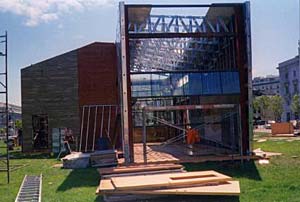
All the material used in building the Scraphouse came from salvage yards, dumps, or waste piles at active construction sites. (Photo: Eileen Bolinsky)
|
KORNFIELD: So let me show you. Come on in and take a look inside. Although really, watch your step here, this is a real hazard. Heads up here, heads up.
[SOUNDS OF DRILLING, CONSTRUCTION]
KORNFIELD: We have a large crew of scrap mongers, scrap salvagers out around the city now. Some of them are here volunteering, but we’re out scavenging. We did a bus tour in that big old green tortoise bus over there around the city with a design team one of the first weeks we were working on this and we went to all the scrap yards and all the junk yards just to get a feel for what was in the waste stream and it was phenomenal the stuff we saw.
[ENGINE REVVING]
KORNFIELD: This is extra glazing from the construction process which ordinarily would just go into the rebox to the landfill. The siding is the stuff that looks like it came out of your, my grandfather’s smoking lounge in the basement of his house in Philadelphia in the ‘50s and it was at the back of some warehouse. So it’s all entirely reclaimed scrap material.
[DRILLING]
KORNFIELD: The structure is metal studs which came out of old tenant improvement and other construction jobs in San Francisco. It’s all patched together, but you know structurally it works if it’s put together right.
[DRILLING]
KORNFIELD: They’re bringing in the leather for the floor.
BLUMENFELD: There’s going to be a leather floor?
| |
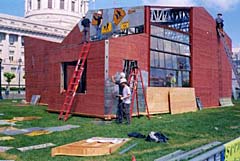
Volunteers put the final touches on the Scraphouse. (Photo: Eileen Bolinsky)

KORNFIELD: There’s a leather floor in the bedroom I understand. And uh, yeah, it’s just, it’s amazing. It will have a large table in the living room, an artist is making out of cardboard, recycled cardboard.
BLUMENFELD: Huh.
KORNFIELD: Which apparently is what his medium is. It’s more than just a one-shot deal. We have to take this and somehow translate it into our daily practices, both at the city and in the construction industry.
VOLUNTEER: Thanks you guys, thanks Jean.
BLUMENFELD: The real lesson is whether you’re building a tree house or an addition or a garage or, you can go and find cool found objects. It’s a house made from scraps.
Related link:
Scraphouse website Back to top

Jared Blumenfeld, director of San Francisco's Department of the Environment. (Photo: Eileen Bolinsky)
CURWOOD: Those last comments come from Jared Blumenfeld. He directs the San Francisco Department of the Environment, and is one of the lead organizers of World Environment Day. We caught up with Mr. Blumenfeld outside City Hall to discuss the aim of the event, and how San Francisco hopes to set an example as a city committed to a green urban environment.
So, Jared Blumenfeld, you're hosting mayors from all over the world for World Environment Day, with a focus on urban environmental concerns. What do you want them to know about San Francisco?
BLUMENFELD: What we want them to know about San Francisco is that we're committed to a path of sustainability, but we don't have all the answers. So part of why we want them to come to San Francisco is to learn about all the cool things we're doing, from recycling to green building to solar power. But really, why we're bringing them here is in the spirit of the UN that was created here 60 years ago, where we had 50 founding delegates. We want people to come here and really share their ideas and vision for how we can create urban centers that are sustainable.
CURWOOD: Um, maybe a little puckish to ask this, but if you bring all these people together, that has a big environmental impact. What, if anything, are you doing to offset the environmental impact of all these folks coming together?
BLUMENFELD: Actually, one of our donors, Swinerton has bought greenhouse gas credits for us, so hopefully we'll end up climate neutral from a climate perspective. But you know, obviously, all these conferences we try to keep it small. So I was very involved in the Rio Earth Summit where they had you know, tens of thousands of people. We wanted just the key mayors and a few of their staff to come together. We wanted to keep the ecological footprint of World Environment Day as minimal as possible. All the meals will be organic, all the meals and events will be zero-waste, so we know nothing will be going to landfill, and all the transportation will be in alternative fuel vehicles, and some of them in things like a $4 million dollar hydrogen fuel vehicle that another transit agency is lending us. So we're really trying to make the event a statement in and of themselves.
CURWOOD: What do you mean by small, and how did you pick the mayors?
BLUMENFELD: Basically, we wanted to invite the largest cities on the planet. So we worked with the UN to pick the largest 100 cities on the planet, and that was our first cut. The next cut was cities like Curitiba that are doing amazing environmental things that we thought we could really learn from. But the 100 that we started with were cities that are just large, that have huge conglomerations of people, some of them in China up to 32 million people, they're like nation states. And we said, you know, it's great to have small little towns like Brattleboro, Vermont that are doing interesting environmental things, but we have to get the big guys involved, otherwise we're not going to save the planet.
CURWOOD: So how the heck do design a World Environment Day?
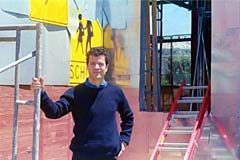
Jared Blumenfeld, director of San Francisco's Department of the Environment. (Photo: Eileen Bolinsky)
|
BLUMENFELD: How we started off was to look at what others had done. But there was no consistency, and kind of like Earth Day in the US, it had lost its buzz, it had kind of gone flat, people celebrated it and it was a big thing, but nothing really ever happened from one year to the next. So the first thing we wanted to make sure was that it was relevant, it had some legacy that went beyond the conference itself. The second thing is that, we wanted to identify a political audience that could be catalysts for change, agents for change, that were not traditional, that were grassroots, that could be held accountable. And as we found out more and more about the demographic shifts in the planet towards cities, and the fact that more people live in cities, we were like, wow, we should invite mayors.
CURWOOD: So you wanted this gathering to have some sort of impact after it happens. How are you going to do that?
BLUMENFELD: So the way we're going to have impact after it happens, after World Environment Day happens, is through a document that we developed called the San Francisco Urban Environmental Accords. And it's basically 21 simple actions that each city can take, and we want them to take them within a seven-year period. And we said, we don't want it to be open-ended, we don't want it to last forever, we want them to do something now. Simple things they can do. And so we developed this checklist.
And what we're hoping is that mayors come together and work together, and rather than have a big plenary session, we're having sessions that are done in what's called World Café style. So we'll have four mayors sitting together, and we'll have probably 200 people in the room, so there'll be lots of different little tables, and they'll all be talking about a common issue: How do you deal with recycling? What are the policies that you've adopted? What are the financial incentives? How do you work with businesses to make this happen? And so then they'll start building networks.
CURWOOD: How did you pick the 21 points?
BLUMENFELD: We worked very closely with the University of California at Berkeley, and with an environmental group called the International Council for Local Environmental Initiatives, to come up with a set of concrete actions that had been taken by at least one city. So each of the 21 actions in the Urban Environmental Accords that the mayors will sign have been taken by one city. We didn't want to invent things that no one had done before. We started with energy, then we went to transportation, urban planning, urban nature, things like trees and parks, water, and they're things that every city has to deal with.
CURWOOD: Jared Blumenfeld is director of the San Francisco Department of the Environment. Thanks for taking this time with me today.
BLUMENFELD: Absolutely, Steve, it's been a pleasure.
Related link:
San Francisco Department of the Environment Back to top

Marie Harrison, Greenaction organizer, and Steve Curwood in front of fish warning signs at the power plant at Bayview Hunter's Point. (Photo: Eileen Bolinsky)
HARRISON: This is actually one of the oldest sections of Bayview Hunters Point right here. This is Evans. The next major street is Third. At the opposite end would be Cesar Chavez. And what’s important about this main run is that this used to be the very main run for heavy trucks, a lot of diesels.
[sitting in the car]
CURWOOD: A block at a time, Marie Harrison points out the industries that line the streets of Bayview Hunters Point, in southeast San Francisco. A mother and a grandmother, and now a community organizer, Ms. Harrison grew up in this neighborhood of African Americans, Pacific Islanders, and the four single largest sources of air pollution in San Francisco.
| |
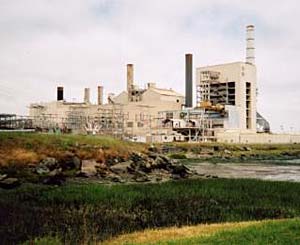
The Bayview Hunters Point power plant in San Francisco (Photo: Eileen Bolinsky)

HARRISON: In Bayview Hunters Point one of the biggest problems we have is we have contaminated soil, we have water that has more pollution in it, more garbage in it than anybody should allow anywhere. We have air that you can cut with a knife because at certain times of the year there’s so much junk in our air, it’s ridiculous.
CURWOOD: On one block there's a metal rendering factory. Down the street, a company that makes the coating for baking pans. A whiff of the air hints of what's to come.
HARRISON: At this corner starts the Southeast sewage treatment plant. This plant goes down to the end of the block. It goes in one, two, three, almost three normal blocks and three blocks down, it backs up to the Southeast Community College, as you go down Phelps Street. It’s a very large place.
CURWOOD: With some very large neighbors, including a naval shipyard that's a Superfund site, and two coal-fired power plants. Marie Harrison used to live in a housing project across the street from Hunter's Point power plant, where residents, including her own family, suffered health problems ranging from asthma to cancer.
HARRISON: My son was constantly breaking out with some kind of rash at the bend of his legs and around his neck. My baby daughter would break out with a rash all over the muscle tissue of her leg and she would scratch and scratch and scratch it.
CURWOOD: Their doctor said the kids would grow out of it but her daughter, who's 32 now, still suffers from skin rashes. Health Department officials told residents - especially African Americans-- that they should exercise more, and watch their diets. Over time, folks like Marie Harrison began to think the problem was not due to their lifestyle or their race.
HARRISON: We begin to notice that the people who moved in and the people who were here, and not necessarily African American folks, but people who moved into our community I guess anywhere between five to ten years, they started having children here, their children were either born with asthma, some type of heart disease or some type of bronchial something going on. There was always something.
CURWOOD: A neighboring family who watered their vegetable garden from well water later found out the water contained arsenic, and the company responsible didn't tell residents about it. Over the years, Ms Harrison says that whole family developed one form of cancer or another. But one event involving her grandson, Roman, changed Marie Harrison's life forever.
HARRISON: They lived across the street from the power plant…and his bedroom window, this is the highest point of stoke for the power plant…he always had to keep it cracked. But every morning, he’d wake up with blood all over his pillow.
CURWOOD: Then one day, the nosebleed turned into an emergency.
HARRISON: Oh God, when Roman was, he wasn’t quite five, my daughter called me in a panic. The ambulance hadn’t got there. First I said I asked her, did you clean the blood around his nose? She said yes but he still couldn’t breathe. He was really tiny and he was screaming. By the time I got there the ambulance was there and they were trying to make him comfortable.
CURWOOD: The doctor at the hospital was reluctant to put Roman in an oxygen tent, Marie Harrison believes, because it’s expensive and the family was on Medicare. When she pressed the doctor for solutions to her grandson's health problems, he said bluntly: move him out of the neighborhood. And that’s just what Marie Harrison did, but not before making a promise to herself.
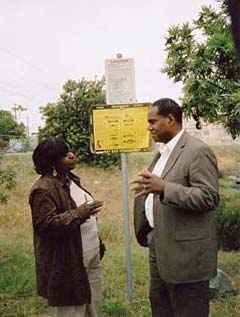
Marie Harrison, Greenaction organizer, and Steve Curwood in front of fish warning signs at the power plant at Bayview Hunters Point. (Photo: Eileen Bolinsky)
|
HARRISON: Somewhere in that time I made up my mind that not only was Roman not going to have to go through this but nobody’s child.
CURWOOD: Now Marie Harrison is a community organizer for Green Action for Health and Environmental Justice in the Bay Area. She organizes rallies, phone calling, and letter-writing campaigns, toxic tours for the public, and she goes into classrooms to educate children. Her main goal is to shut down the polluting power plant, but that's just a start.
HARRISON: We know for a fact that this plant plays a big part of the picture but we know that it’s not the only source of our ills and, shall I say, our misdeeds. And we know that any person here will say that this power plant has got to go, we understand what it’s doing to us, but it’s not the only thing here. We understand that there’s more than one Goliath here. We can only take on one at a time.
CURWOOD: For years now, public officials have promised to shut down the plant, only to renege as the deadline approaches. The present mayor of San Francisco, Gavin Newsom, pledges to shut Hunter's Point down in two years. Marie Harrison says she'll believe it when she sees it. Opponents say shutting down the power plant will cost the city too much money. But Ms. Harrison says the city pays either way.
HARRISON: It should not, would not, cannot, and we won’t allow it to be, whichever is the cheapest because a lot times when you think about the bottom line the technologies that they use depend on how little it’s gonna cost. Well, if you add up the medical bills for one person who goes into the emergency room how many times a year, the medicine, how many times a year they have to have it refilled, and how many times do they have to call an ambulance to take them to the emergency room. When you start adding up those costs for one person, times how many persons live in our community, times how many people live in the city, wouldn’t it be cheaper to say, you know, there’s gotta be a better way to do this. I can’t be happy until everyone is moved out of harm’s way.
Related link:
Green Action for Health and Environmental Justice Back to top
[MUSIC: “Durant Station” Charlie Mullelwhite: Connections 2- A compilation of California Musicians (Jackalope) no date]
CURWOOD: Just ahead, new hope for sustainable community redevelopment. First, this note on emerging science from Jennifer Chu.
[MUSIC: "High and Dry” Radiohead: The Bends (Capitol) 1995]
CHU: There’s a new culprit on the list of eco-unfriendly enterprises. The music industry, which some folks blame for noise pollution, is now being criticized for its greenhouse gas emissions. Taking most of the heat is British pop band Radiohead whose lead singer, Thom Yorke, recently joined a “Friends of the Earth” campaign to reduce carbon dioxide emissions in the United Kingdom.
But, The Sunday Times in London, with the help of The Edinburgh Centre for Carbon Management checked up on just how environmentally friendly Yorke’s band is. They analyzed the band’s latest tour and found that the five hundred thousand fans that traveled to these concerts generated more than five thousand tons of carbon dioxide.
In addition, Radiohead racked up an estimated 50,000 air miles during the tour, producing fifty-four tons of CO2. And finally, two thousand tons of CO2 were produced in making the CD “Hail to the Thief.”
In all, Radiohead’s tour contributed an estimated 7 and a half thousand tons of carbon dioxide to the atmosphere. That’s what one thousand, four hundred cars produce in a year. Bands including The Rolling Stones, Coldplay, and Pink Floyd have attempted to offset their carbon pollution by planting trees, which absorb carbon dioxide. For Radiohead to follow suit the band would have to plant 50,000 trees and maintain them for a hundred years to offset the pollution from their latest tour. That’s this week note on emerging science, I’m Jennifer Chu.
Back to top
CURWOOD: And you're listening to Living on Earth.
ANNOUNCER: Support for NPR comes from NPR stations, and Verizon, providing 4-1-1 directory assistance for residential and business numbers locally or across the country; the Kresge Foundation, building the capacity of nonprofit organizations through challenge grants since 1924. On the web at kresge.org; the Annenberg Fund for excellence in communications and education; and the W.K. Kellogg Foundation, from vision to innovative impact, 75 years of philanthropy. This is NPR, National Public Radio.
[MUSIC: “Midnight” Markus James: Connections 2- A compilation of California Musicians (Jackalope) no date]
CURWOOD: It’s Living on Earth. I’m Steve Curwood.

Van Jones, Executive Director of the Ella Baker Center for Human Rights, and Steve Curwood at the former site of the Red Star Yeast Factory in West Oakland. The reclaimed site will be developed into a community training center. (Photo: Eileen Bolinsky)
CURWOOD: It’s no coincidence that the landscape of Oakland, California resembles something out of a Star Wars movie. George Lucas modeled his storm trooper carriers after the huge white cranes that sit along the city's port, methodically raising cargo from incoming tankers to waiting railcars. These cranes are a symbol of just how much industry is a part of the city…and for that matter, how much commerce is part of the nation. But people like Van Jones believe part of Oakland's community pays more than its fair share of the price. On any given day, Van Jones says, factories and trucks spew fumes into the air that have created some of the highest asthma rates in the country, as well as other illnesses. A lawyer by training, Mr. Jones is executive director of the Ella Baker Center for Human Rights, and he says by cleaning up the city, he can help people breathe easier, live safer, and get better jobs. I met up with Van Jones at an abandoned city lot on a busy city intersection in industrial West Oakland.
| |
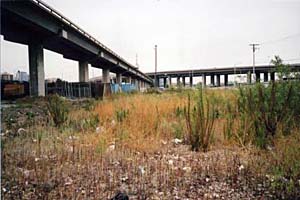
The site of the former Red Star Yeast factory is surrounded by highways used for trucking material to all parts of the country. (Photo: Eileen Bolinsky)

JONES: West Oakland is a community where 80 percent of the folks who live here live within an eighth of a mile of an industrial site, um, literally a stone’s throw, so it’s very, uh, unhealthy. It’s an asthma epidemic. You know, you go to the public schools, you know you see little second and third graders, more than half of them have an inhaler in their pocket. Um, I mean, it’s really an epidemic here and so the struggle in west Oakland, not just for jobs and economic development, but for economic development that won’t make things worse…
CURWOOD: Uh-huh.
JONES: That’s the whole game. That’s what it’s all about.
CURWOOD: Who lives here?
JONES: Um, black folks live in west Oakland. (LAUGHS) You know, west Oakland is, uh, traditionally African American, low income, working class community. Um, more and more different kinds of people, you know, live here, but you know west Oakland is still considered an African American community. And it used to be a brilliant, beautiful, thriving, amazing place and then over time like so many urban communities it fell on hard times and it fell prey to, you know, polluters, toxifiers, and one of the worst, um, was the Red Star Yeast Factory.
CURWOOD: Uh-huh.
JONES: If you see this big empty lot here…
CURWOOD: Yeah.
JONES: This used to be, uh, one of the nastiest smelling industrial sites anywhere in northern California. I mean because they’re making yeast the kinds of smells that would be coming out all hours of day, the noise, um, was just horrendous. For a while, people just accepted it, but then a local community organization did some research and found out that it wasn’t just that it was bad smells, but that it was carcinogenic and that explained a lot of the health issues around here. And so there was a community mobilization to shut this place down and you can see we won.
CURWOOD: At this Red Star Yeast plant, what came out that was so toxic?
JONES: Well, carbon monoxide was coming out. Sulfur dioxide was coming out. Something called acetaldehyde. I mean there were chemicals coming out the community people couldn’t even pronounce. And the only thing that we knew was that our children were being hospitalized for asthma at seven times the rate of any place else in California. And so, we knew something had to be done.
CURWOOD: So, um, what happened here to shut down this plant? One day it’s here, the next day it’s gone. It took some kind of work. What was it?
JONES: Well, you know, we’re lucky because in west Oakland and really all across America we have environmental heroes and sheroes who were willing to stand up. The Pacific Institute who, you know, have PhDs and scientists and stuff on staff, you know they did an environmental indicators project and discovered all these poisons that were coming out into the community. And then we had heroes like, um, you know, Margaret Gordon who’s an African American grandmother, who you know, won’t take it, you know. And she and others like Mia Mazinatoto stood up and stood up to the powers that be.
CURWOOD: What did they do? Did they march, did they picket, did they protest, did they sit-in, did they write letters? What did they do?
JONES: Yes. (laughs) They did it all. They did everything from, you know, writing letters, having sit-down meetings. But mainly what they did was they did some civil disobedience. They said, listen you can’t bring those trucks in and out of here any more. And they went to the air quality management district that had been asleep at the wheel for decades letting this poison go and they brought the facts and the figures and they got this thing shut down. And by them shutting this one factory down, they opened up the possibility for west Oakland to become a community that everybody can be proud of.
CURWOOD: These days environmental activism and civil disobedience, those two phrases don’t go together that often. Why do you suppose that is?
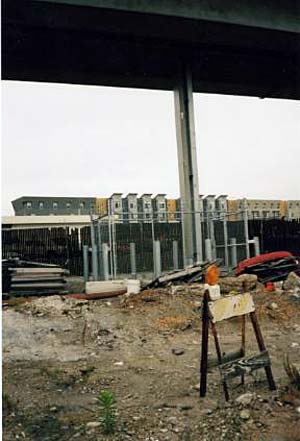
Residential buildings are just a stone's throw from what used to be the Red Star Yeast factory. (Photo: Eileen Bolinsky)
|
JONES: You know, I just think that we’ve forgotten our history. I think that the people want the civil rights movement to either just be Dr. King giving a speech or they just want it to be the Black Panthers you know, raising a fist. And the reality is that you have people of all colors coming together across the country that have different visions for America, wanted America to lead the world in human rights and were ashamed of the failures of this country to live up to its best promises and they changed the country, absolutely changed the country.
Similarly now across the country you have people who are very concerned about America leading the world in pollution, in consumption, in waste. Driving the global warming crisis to a peak point and those people are not just white affluent people who live the suburbs. People of color read the newspaper too. And we want to see a change happen that will not only benefit the global, uh, situation, but also can make our community stronger and that’s what this new urban environmentalism allows for.
[WALKING THROUGH EMPTY LOT]
JONES: I got to tell you it feels good to be walking on, uh, what used to be, you know, this place was killing people.
CURWOOD: So now, has the asthma rate improved here?
JONES: Um, the asthma rate, has improved marginally. The other problem that we have is that we got the biggest stationary source removed, but then look over here. When you’re standing in west Oakland the port is right over there. Products come here from all around the world. Big diesel trucks come and idle in our community to take those products to the suburbs, to the affluent areas, but we bear the burden in our lungs of those trucks sitting there to take something out to the malls all over the country. Um, why can’t those trucks use biodiesel? Why can’t those trucks use clean energy so that as this commerce is happening and benefiting people over, abroad and throughout America, we’re not suffering. That’s jobs. Skilled jobs, what we call green collar jobs.
CURWOOD: Green collar jobs.
JONES: That’s what we want. Blue collar jobs are the jobs of the past with the manufacturing that’s leaving. White collar jobs are jobs that people aspire to but often it’s narrow at the top. But, you look around you, there’s no amount of, you could have a hundred people here right now working, uh, to improve the way this place looks and feels, they’d be working here ten years from now because there’s so much because there’s so much urban renewal at work. There’s so much urban restoration that is required now. As more people come into the city, they’re coming to urban areas.
CURWOOD: OK, here we are, the San Francisco Bay has 200 plus mayors from around the world here gathering for World Environment Day. They come from anywhere from Kabul in Afghanistan to Shanghai in China to Curitiba in Brazil, London, England. What’s the message from Oakland, California from you Van Jones to these mayors?
JONES: Well, uh, the message is that environmentalism is not an elite issue. It’s not an issue that’s just for the affluent people to be concerned about. That the environmental, uh, burden of community health and sickness and death falls on the slums. It falls on the poor. What we want to say is that every single mayor who’s here has a slum in their community. They have a low-income area. They have a ghetto. They have a barrio. In every slum put a green job training center so that people can come in and learn how to do rain water reclamation, permaculture, uh, how to put solar cells up. Help people who have economic needs and community health needs meet those needs through a new environmentalism. That’s about social uplift as well as saving the planet. That’s what we’re saying. You know, one of the reasons that we do what we do in holding out a different vision is Dr. King didn’t get famous with a speech called, “I have a complaint.”
CURWOOD: (laughs)
JONES: He had a dream. We have a dream in west Oakland.
CURWOOD: So, uh, if you were going to give this speech today, and it’s 2005 and not 1963 what would you say? I have a dream, dot dot dot.
| |
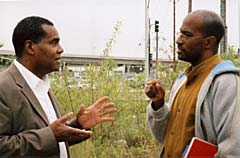
Van Jones, Executive Director of the Ella Baker Center for Human Rights, and Steve Curwood at the former site of the Red Star Yeast Factory in West Oakland. The reclaimed site will be developed into a community training center. (Photo: Eileen Bolinsky)

JONES: Well, you know, I dream of seeing these young sisters and brothers out here in the community moving from jail cells to solar cells. You know what I mean, I imagine a situation where places like Oakland, Watts, Newark, Detroit, these places could be Silicon Valleys of green capital. These places could be the models of, you know, model cities really that show that you can have zero pollution, zero poverty and zero displacement of the people who live here if you just invest in giving them skills to have green collar jobs. I believe that green collar jobs to put urban America back to work and to restore urban America is the silver bullet solution for the environmental and social problems we’re facing here in west Oakland and across the country.
CURWOOD: Van Jones is the executive director of the Ella Baker Center for Human Rights in Oakland, California. Thanks for taking this time today.
JONES: Well, thank you. Come back we’re going to be a world leader for the green economy. Come back and do that show too.
Related link:
Ella Baker Center for Human Rights Back to top
CURWOOD: Changing attitudes can take a long time. Right in the same city as Van Jones there’s a school that's developed a successful recycling program. You’d think it would be litter free. But that's not the case at Oakland High School, where each month enough garbage is generated to fill a classroom to the ceiling. The school’s Environmental Science Academy is in its seventh year. But only ten percent or so of the school’s student population takes part in the recycling efforts. As Youth Radio’s Ricky Zhang explains, the enthusiasm of Academy members for cleaning up the campus is taking its time to rub off on their classmates.
ZHANG: Walk through a stairwell after lunch at my school, and you’ll be tripping over chip-bags and soda cans, and wading through a garden of sunflower seeds freshly watered with saliva. Fusima Latu says she wishes kids would think more about what they’re doing.
LATU: Kids think it’s not cool to throw your trash away, but, you know, it would be like, would you go to your house and live in a pile of trash?
ZHANG: Obviously, some kids do care how our school looks…Oakland High has a serious recycling program. It’s part of our Environmental Science Academy, or ESA, a special academic program for kids into science and nature. Kevin Jordan is a science teacher who helped found ESA.
JORDAN: Basically, in Oakland, we have a culture of trash and our kids grow up, often times, uh, maybe in households where recycling is not going on and seeing trash on the streets. Our neighborhood’s in trouble. So when we’re trying to get them to recycle here often times we’re really starting from zero.
ZHANG: Oh my God! Did Mr. Jordan just say we have a culture of trash in Oakland? I should be appalled by that, but honestly, I’m not! Mr. Jordan has a point…
JORDAN: You know, here I am getting these kids to do this task that is not real desirable, and one of them was carrying a recycling bin – and took a punch while they were carrying the recycling bin out to the recycling place outside. So at that point we have to really look at, “Are our hallways safe enough to carry out this task?”
ZHANG: Apparently not, because Mr. Jordan says he shut down the recycling program for about a month after the punching incident. That made life even harder for Oakland High’s two daytime custodians, who handle garbage generated by over two thousand students. What does custodian Sylvester Lawston see?
[SOUND OF LAWSTON DUMPING TRASH]
LAWSTON: You know I see a lot of trash that I throw away that should be recycled, but you know, my job is to throw away trash and if it’s in the cans I got to throw away I’m not gonna separate it, you know, I mean, but, I see a lot of waste.
[HALLWAY SOUND]
ZHANG: Well, I see a lot of waste too…There’s the trash can – there’s a trail of ants all over it! Look at all these ants – that’s just disgusting!
[HALLWAY SOUND]
ZHANG: Marisol Ochoa thinks she knows why recycling hasn’t rubbed off on everyone. She says, while she and other ESA students go on cool field trips to the local lake or the dump, the general population at Oakland High never learns where trash really goes.
OCHOA: Like they don’t know exactly what happens to that piece of gum. It goes into the water, it goes into the, um, it goes into our lake – into our ocean, and in ESA you learn about all that stuff. We see what happens. We see the results.
ZHANG: Lanikqua Howard is also in ESA. She has her own theory to explain our trash complex.
HOWARD: In some manners it might be psychological. Students don’t throw away their trash… ‘cause they might feel like… oh, I don’t like this school, or teachers, they give me bad grades so I don’t care about this school – and I’m just going to trash it – but that’s not fair to other people who do actually like this campus.
ZHANG: But of course, I can’t just talk about litterers. I need to talk to one, too…Like senior Lindsay Castillo.
CASTILLO: I want my neighborhood to look better than my school, usually because, that’s where I live – you know, it’s like my sanctuary.
ZHANG: But, Lindsay says school is just a place she has to “get through.” So she “accidentally” drops her wrappers and cans on the floor at Oakland High all the time.
CASTILLO: The school does bring the worst out of you – that’s probably why, it can encourage littering – mostly because it’s a stressful environment.
ZHANG: Sure, it’s stressful. But there are so many wonderful things about our school. Like, in my English class, there are students who speak seven different languages. And we have some kick ass homecoming rallies. But I get embarrassed bringing people to my school, because I’m deathly afraid they won’t see past the trash, and they’ll think of it as just another low ranked Oakland public school. For Living on Earth, I’m Ricky Zhang.
CURWOOD: Our story on recycling at Oakland High School was produced by Youth Radio’s Environmental Desk in association with National Geographic.
Back to top
[MUSIC: “The National Anthem” Radiohead: Kid A (Capitol) 2000]

A San Francisco trolley rolls through the city.
(Photo: Susan Trotz)
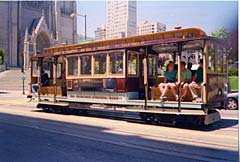
A San Francisco trolley rolls through the city. (Photo: Susan Trotz)
|
[EARTHEAR: “Cable Cars” Eileen Bolinsky]
CURWOOD: We leave you this week with a signature sound from the city by the Bay. Living on Earth’s Eileen Bolinsky recorded the action at the Powell Street cable car turnaround station.
[MUSIC AND PEOPLE TALKING]
Back to top
CURWOOD: Next week on Living on Earth, Mexico City has a water problem. During the rainy season, water runs off its streets and can’t be captured for drinking. But a new type of pavement lets the water reach the wells.
MAN: Water goes through it and I felt my soul was going everywhere around the world. I told him Heimen you just discovered something everyone in the world is looking for.
CURWOOD: A concrete solution to big city water problems, next time on Living on Earth.
Living on Earth is produced by the World Media Foundation. Our program from San Francisco was produced by Eileen Bolinsky. Our crew includes Jennifer Chu and Steve Gregory - with help from Jennie Cecil Moore and Kelley Cronin.
Our interns are Max Thelander and Sarah Williams. Our technical director is Paul Wabrek, Alison Dean composed our themes. You can find us at living on earth dot org. From San Francisco, I'm Steve Curwood. Thanks for listening.
ANNOUNCER1: Funding for Living on Earth comes from the National Science Foundation, supporting coverage of emerging science; and Stonyfield Farm. Organic yogurt and smoothies. Stonyfield pays its farmers not to use artificial growth hormones on their cows. Details at Stonyfield dot com. Support also comes from NPR member stations, and the Ford Foundation, for reporting on U.S. environment and development issues, and the Oak Foundation, for coverage of marine issues.
ANNOUNCER2: This is NPR, National Public Radio.
Living on Earth wants to hear from you!
Living on Earth
62 Calef Highway, Suite 212
Lee, NH 03861
Telephone: 617-287-4121
E-mail: comments@loe.org
Donate to Living on Earth!
Living on Earth is an independent media program and relies entirely on contributions from listeners and institutions supporting public service. Please donate now to preserve an independent environmental voice.
NewsletterLiving on Earth offers a weekly delivery of the show's rundown to your mailbox. Sign up for our newsletter today!
 Sailors For The Sea: Be the change you want to sea. Sailors For The Sea: Be the change you want to sea.
 The Grantham Foundation for the Protection of the Environment: Committed to protecting and improving the health of the global environment. The Grantham Foundation for the Protection of the Environment: Committed to protecting and improving the health of the global environment.
 Contribute to Living on Earth and receive, as our gift to you, an archival print of one of Mark Seth Lender's extraordinary wildlife photographs. Follow the link to see Mark's current collection of photographs. Contribute to Living on Earth and receive, as our gift to you, an archival print of one of Mark Seth Lender's extraordinary wildlife photographs. Follow the link to see Mark's current collection of photographs.
 Buy a signed copy of Mark Seth Lender's book Smeagull the Seagull & support Living on Earth Buy a signed copy of Mark Seth Lender's book Smeagull the Seagull & support Living on Earth
| | | | |

